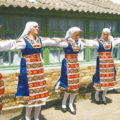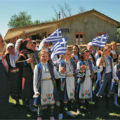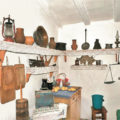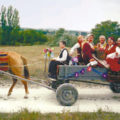Historically, the territory of Russia has not just been home to numerous indigenous peoples. The land is also shared by the descendants of immigrants who continue to carefully preserve their national traditions.
In a small neat house in the village of Chernopolie situated in the Belogorsky district of the Crimean Peninsula there lives an amazing woman, who has preserved ancient Thracian songs that her grandmother used to sing. Her name is Irina Zekova, and she is the chair of the local Greek community. Even though she is in her 70s, the songs she performs still fascinate everyone. People treat them like everyday prayers. Ethnographers from all over the world study the life of these extraordinary individuals. Thracians of advanced age come here from around the globe to thank the residents of Crimean Thrace for their careful attitude to great people’s memory and take a handful of Crimean soil home. There are numerous books and TV spots about Chernopolie. Last summer, a Greek director Stelios Elios presented his documentary called “Dear Thracian Greeks of Crimea” here. A local young researcher of Greek origin, Sofia Kifnidi, also prepared an interesting scientific work on this issue.
The ancestors of today’s Thracians who were saved by the Russian Empire from the Turkish yoke moved to Crimea two hundred years ago. There they built the church of Equal-to-the-Apostles Constantine and Helen and opened a school and ethnographic museum. Their parents’ instructions to love this holy land helped the newcomers sail through all the challenges in life. The Greeks became worthy members of the multinational family of Taurida.
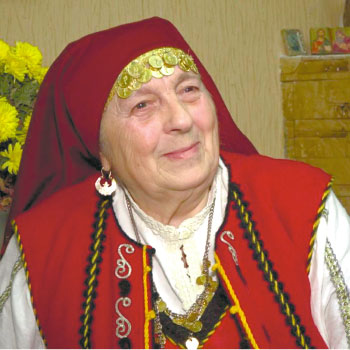
Irina Zekova, chair of the Greek community
The memory of their historic homeland that has long been divided between the neighboring countries is carefully preserved in the priceless monuments of musical culture, Thracian folk songs. There are lots of them, and they tell us, the descendants, how the Thracians — a large nation of warriors and workers, talented craftsmen, and skilled farmers — lived, worked, fought, and won. For 400 years, boys were taken away from their families and sent to Turkish camps for Janissary military training.
Most of the songs were devoted to labor, in particular, harvesting. They accompanied the hard work of reapers. These songs have slow melodies that let voices ring out above the field and be heard by other reapers, both in vicinity and far away. The bizarre curves of the Phrygian and Dorian musical modes enriched the melody, and the rhythmic freedom reflected the leisurely movement of the harvesters.
Another major group of work songs are the ones for gatherings. They were sung when girls and brides came together to spin, sew, or shuck corn. While working, they sang dozens of beautiful songs, most often about love. One of them tells about a guy who was passing by the gathering and stopped to admire his beautiful darling. “Go, mother, and play matchmaker, so that lovely Mariyka will be mine,” — this is what this song is about.
Drinking songs had a special place in the life of the Thracians. They were sung by both men and women. But if the latter preferred the love ones, the men’s drinking songs were about past historical and heroic events, “…The forest turned green, and only one tree is not covered with leaves; under it lies a young man with ten fierce wounds…”
And to this day, elderly Thracian women remember the ritual songs that accompanied the holiday calendar. The brightest of them are carols and lazarki. They were performed on Christmas eve in winter and on Lazarus Saturday in spring. The songs of men-carolers are the most cheerful and optimistic in Thracian folk art. They include wishes for each family member. One of the songs about a bachelor tells about the three guys who gathered to brag about and argue who was the most successful.
Thracian lazarki were performed a week before Easter, on Lazarus Saturday. They were part of the girls’ spring games. Festively dressed in beautiful wedding-like folk clothes, with flowers in their hair and ringing jewelry, the girls sang and danced in every house of the village. This way, they introduced themselves to the community and declared their readiness to get married.
Another traditional ritual is related to St. John’s Day. The night before the holiday, two girls go through the whole village in silence, get a bucket of water from the holy spring and, together with wreaths of fragrant Crimean flowers and herbs, carefully take it to the house, where the old icons that were brought by the Thracians two hundred years ago are kept. Next, three ripe wheat spikelets and wedding silver ring are woven into the wreath, which is beautifully tied up in a red ribbon after that. This wreath goes to one of the village girls, who then receives wedding attributes from older women as a future bride. This ritual embodies summer, profit, and an opportunity to create a new family.
Today, the songs with wishes for happiness and fertility are performed at folk art fairs by amateur groups.
Out of all family ritual songs, the wedding ones are preserved best. Thracian wedding is a rich ritual, and each of its stages was accompanied by special songs. Among the most prominent ones are the young bride’s farewell to her parents and home.
The most popular Thracian musical genre, which has survived to date, is horo — collective circle or line dance. The rhythms of the horo vary greatly, and there are different types of this dance in each of the key areas that once belonged to Thrace.
All across these places, as once in Thrace, both the old and the young ones meet in the horo. It is the most massive and favorite round dance everywhere: at home, in a restaurant, in squares and streets. It is danced on various occasions: official holidays, weddings, graduation parties, birthdays, etc. As soon as the first sounds of familiar music are heard, everyone begins to follow the rhythm, and the bravest start to dance. Gradually, others join them, and in 2–3 minutes the dancers do not have enough space to turn around. The Thracian horo used to be danced to a song, but now it is not. However, the round dance songs are preserved to present day. They are a vital part of every family celebration.
The performance of Thracian songs and dances is one of the main traditions of ethnic cultural societies not only in the former Thrace, but also in Russia. Thus, there is a unique national musical ensemble Karachol, a creative team established in Crimea, in the Chernopolie village. It is the only place in the Russian Federation, where Thracian ethnic traditions are carefully preserved, holidays are celebrated, and amazing songs still can be heard. There are only ten old-timers left in the village who are the living witnesses of history. Today, the primary task for the modern Thracians is to safeguard this wealth, beauty, and uniqueness for future generations.
Luchiya Puzikova, Member of the Russian Union of Journalists

